News
Winning Moments ...
Click on links to go directly to William Dubois' blog entries ...
Ultimate beer run
The milk run for wine
Weatherwise is never wise enough
Shaken, not stirred
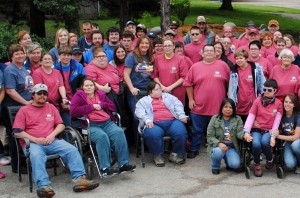
William Dubois lives in New Mexico. He is a writer of aviation articles for magazines circulated nationally and internationally, he also writes a weekly blog which he shares with his readers around the world... This week his blog happens to be about a trip to Great Bend, Kansas... where he discovered Rosewood Wine...
The story is light hearted and entertaining...but it also left me with one of those spontaneous moments of pride, and the realization that 18 years ago, the thought we would be getting mentioned internationally someday, never crossed my mind.
My moment of pride is not just in the wine, or the Winery, or the Cellar where it was purchased...it is about all of us... It is about the team we have become, a diverse team creating options for the folks we serve so they to have opportunities to make a difference in the lives of others, in such a way that is enriching for all... It is pride in our clients and who they are becoming, it is about the staff that helps folks get ready in the morning, the drivers who pick them up and bring them to work, staff that work with them durning the day...supervising them, encouraging them, it's about staff working behind the scenes, keeping them healthy, tracking appointments, people ordering ingredients for products to be made, people unpacking and packaging, people delivering products... We quietly have became a team of hundreds who are so closely intertwined, that the things each of us do everyday...effect all of us...and one of the products of that team...in this case a bottle of wine...is providing all of us with a "winning moment" courtesy of William Dubois.
Thank each and every one of you for the part you play on our team.
Tammy
Here is his story as it appears in William Dubois' blog Plane Tales ~

Posted on January 22, 2016
Ultimate beer run
It was love at first sip. The wine was bold. But smooth. It carried a range of flavors that was a symphony for the taste buds. It also didn’t hurt that it was only nine bucks a glass, and was paired with the best steak I’d ever had in my life.
That’s one of the grand things about aviation: You just never know what you’ll discover on an overnight fuel stop.
The wine was called Copper Prophets, and it’s made by the Rosewood Winery in Great Bend, Kansas. Beyond making one the best reds I’ve ever had the pleasure to drink, it turns out that Rosewood also has the distinction of being a winery with a cause. Their staff is made up of developmentally disabled people. Making wine is both therapy and gainful employment.
My first brush with the wine was on my way to the Ercoupe 75th Anniversary gathering and the massive annual air-meet at Oshkosh. I jotted down the oddball name of the wine on the margin of a flight log (all Rosewood wines are named after race horses raised by their sister operation, Rosewood Ranch) and somewhere in the middle of Missouri, grounded by fog and low clouds, I went online to try to order a case so it would be waiting for us on our return home. No joy. Rosewood does not sell online.
Not to be deterred when it comes to good wine, I re-routed our return flight to stop over in Great Bend a second time, and as soon as we landed we jumped into the Centerline Aviation crew car and headed for Rosewood’s retail “wine cellar” in downtown Great Bend. But as it turned out, Rosewood isn’t licensed to export their product out of state, and between Rio and I, fuel, and tee-shirts and tooth brushes, we literally could not carry even a single bottle back with us. This is one of the disadvantages of antique airplanes. Built in the days when people were smaller and lighter, and when there was virtually no cockpit gadgetry, they don’t have much carrying capacity—what we call “useful load” in aviation. When you add in modern conveniences like, say, a radio or a starter, it only gets worse.
What to do? It was either leave Rio behind, or leave the wine behind.
In the end I bought the wine and then hit the streets to make friends with Kansasions to try to find someone to ship it home to me. It was a lot of work, and a little nerve-wracking, but eventually my wine reached me. Oh, I forgot to mention, it might be cheap by the glass, but by the bottle, it turned out to be the most expensive wine I’ve ever purchased. We saved each bottle for special occasions.
It’s amazing how many special occasions we have in our household.
So we were down to two bottles when the Plane Tales Plane went into the shop for her recent epic annual inspection (not a special occasion, although I suspect my mechanic might have broken out a bottle of his best when he saw me taxi up), and then she cracked a cylinder (also not a special occasion).
Sorry it’s taking so long to get to the point of the story, but it’s complicated.
So as it turns out, new cylinders have a special break-in procedure. Basically, you need to run the engine hard for the first ten hours or so. High power. Low altitude. Minimum landings. Short taxiing. In a nutshell, the recipe for a road trip, which in aviation we call a “cross country.”
In the old days, to plan a cross country like this I would have sat down at the kitchen table and spread out a sectional chart. Or, if I’d been at the airport, I would have gone to a planning chart: Huge 7-foot tall maps of the United States that covered entire walls. Most terminals used to place a screw in the map at their location. Attached to the screw was a piece of string with knots tied into it every hundred miles or so. You could swing the string around to estimate the distances to faraway places.
Instead, I sat down on the living room couch with an iPad Mini. And a glass of cheap wine. I need a trip of around 400 miles, the theoretical maximum distance I can go with full tanks, a legal reserve, and no copilot. (I’m flying solo until the engine is safely broken in.)
“Maybe I could fly over to Dalhart for breakfast,” I told Rio. I simultaneously laid my left index finger over our homebase on the touch screen, and my right finger over Dalhart. Two simulated black pushpins appeared on the screen, with a line drawn between them. Only 154 miles. “Not far enough,” I sighed.

“Still too close,” I said, then looking at the chart, and talking more to myself than to Rio, added, “I wonder what’s further east…?”
“Well you could just fly to Great Bend and pick up another case of that wine you love.”
Three hundred ninety seven miles.
The boy’s a genius.
Access William Dubois' story on his Plane Tales blog at http://www.planetales.net/plane-school/ultimate-beer-run
Below, read about William's return trip to Great Bend for Rosewood Wine ...
Posted on January 29, 2016
The milk run for wine
We flew low and hard. I’m using the Lindberg We here, as I was alone in the plane. Alone, but not alone, as I had the plane for company. Her retooled engine, overhauled carb, and newly flattened propeller combined to create a comforting roar that was oddly musical as she tore her way through the sky.
I had lifted off at dawn, Tessie springing into the air with renewed vigor, even with a full load of fuel, and I had to force her nose down to keep her low to the ground, as advised by our mechanic. The mission (beyond restocking our wine cabinet) was to “set” the rings in our new piston, and this is done by keeping the pressure in the cylinder high—a project made more challenging by flying out of an airport nearly a mile above sea level. In this case, altitude was the enemy.
The sun rose as I skimmed over mesas and canyons towards the Texas border, and about 45 minutes after takeoff I dropped off of the escarpment and down into the flatlands. From here through the Oklahoma panhandle, and into Kansas, you can forgive our ancestors for believing that the world was flat. Even from above, there is nothing about the great plains of the Midwest to suggest that they reside on a giant sphere. The land is a smooth, near-featureless expanse in all directions. A expanse that seems to go on forever.
Lower and lower we flew as the terrain slowly and steadily dropped in altitude beneath our wings. My main tasks were watching out for those pesky cell phone towers, and keeping track of my theoretical fuel consumption, based on ground speed. Ercoupes don’t have reliable gas gauges and there’s no real way in flight to check how much is in the wing tanks. I stayed on task, and resisted the urge to carve lazy circles in the winter air.
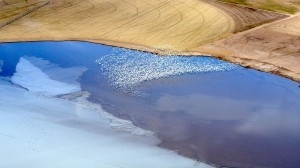
But all in all, it was what military pilots used to call a milk run. The same would not be true of the return trip. But I’m getting ahead of myself.
When I landed at Great Bend, the Centerline Aviation lineman greeted me with, “We haven’t seen you for a little while. Welcome back.” It wasn’t artifice. Next he asked if a minor mechanical problem we’d had when we last passed through had gotten resolved.
That’s the wonderful thing about aviation: It gives you an extended family.
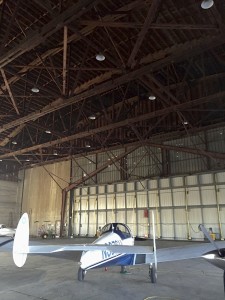
At the Rosewood outlet the manager recognized me and we chatted for a time. As much as I love my Cooper Prophets, I’d been noticing that recently my pallet was sliding away from smoother Malbec-like wines to slightly sharper cabs. What followed was a wine tasting that left me wishing I had room for two cases of wine, not just one.
Seriously, I don’t think these people make a bad wine. Of course some I liked better than others. In the end I took home a mixed case made up of: Coosa Pat, a Portuguese Cabernet Sauvignon ~ Chicka Star Buck, a Bonorda Malbec ~ Angel with a Gun, an Amarone ~ Peponita Pop Top, a Pinot Noir.
And of course I got one more bottle of my beloved Cooper Prophets, the Nebbiolo that started all of this. Oh, and one bottle of a yummy chocolate raspberry desert wine (in a sexy skinny bottle) for Debs called Boo Koo Good Time. Remember, all these wines are named for race horses, which tend to have racier names than airplanes do.
I see many special occasions in my future.
Then I checked the weather, and turned in for the night, having no clue that the next day would be no milk run. Or even a wine run, for that matter. But I would be running from something, all right, before the first hour of the flight was over.
Access William Dubois' story on his Plane Tales blog at http://www.planetales.net/airport-adventures/the-milk-run-for-wine
Below, read about William's eventful trip home ...
Posted on February 5, 2016
Weatherwise is never wise enough
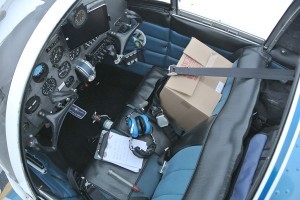
I did a running runup, checking the mags and the carb heat as I taxied, so when I reached the end of the runway I made my radio call and rolled right onto the 100-foot-wide mile-and-a-half long stretch of asphalt without stopping.
It was cold and cloudy, with a solid ceiling about 3,000 feet up. As I was still generally flying at 500 feet, this was not an issue at all. I’d studied the weather in my hotel room before driving out to the airport and it looked like the cloud cover would stay with me for about the first quarter of the trip. There would be some low—but legal and safe—ceilings near Dodge City, but the airports beyond were reporting clear skies.
I lifted off, banked left at 500 feet, and headed west, anticipating a late breakfast at the Red Barron in Dalhart, and being home with my new case of wine by noon.
Neither of those things happened.
Half an hour into the flight something odd happened to the horizon. It turned white. A knot formed in the pit of my stomach. This didn’t look good for the home team. I tried to tune into the Dodge City automated weather broadcast, but it was still too far away. I activated the weather reporting on my iPad and was stunned to see a red dot above the Dodge airport. I clicked for details and learned that the airport was shrouded in freezing fog with virtually no visibility. As I looked wider, airports to the north seemed clear, while airports to the south were reporting low, but legal ceilings. Deviating north seemed to be the best option. But as I approached the great while wall I could see an orange glow to the south. The sun was trying to break through down there. Looking north, the color of the sky was such a dark grey as to nearly be evil.
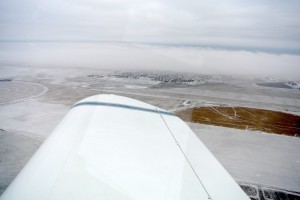
After flying south for about ten minutes I thought I’d found the end of it. I turned west again, congratulating myself on my superior airmanship and decision-making skills. Still, I kept one eye behind me to ensure that I had a safe escape option.
Everything was going fine, when suddenly the clouds exploded downwards and patches of fog sprouted up everywhere below me. The way ahead became dangerous, and the escape route behind was closing off.
It was clear I couldn’t get the hell out of Dodge because I’d never get there.
I did a quick one-eighty and dropped down to 400 feet. Then to 300 as the cloud deck chased me. It’s hard to estimate how far above you the wispy grey tendrils are when you look up at them through the clear canopy, but I knew for damn sure I couldn’t risk flying into that soup. It was time to get on the ground. I called up the nearest airport on my flight pad: Kinsley. I selected the “Direct To” command and a course was plotted for me.
As I came in low over the farm fields, I could see neither hide nor hair of the airport, even though my navigation said I was right on top of it. Finally, I spied the hangars and then the strip: A frozen ribbon of white, narrow and short. Was it snow or was it ice? There was no way to know from above.
Still, any harbor in the storm. I’d rather risk sliding off the runway and pranging the plane than fly into the grey soup and risk ramming a cellphone tower or some other cloaked obstacle at full speed.
I wheeled over the airport and entered into a low downwind pattern for the north-facing runway. I wanted to touch down at the slowest possible speed and give myself as much runway as possible to slow down without braking. I powered back, raised the nose and slowed the plane to the lowest airspeed I dared use, and aimed for the first few feet of the runway.
Slowly, slowly, down we came. The wheels touched the white-cloaked asphalt, and…
Nothing happened.
It was a totally uneventful landing. I decided it must be snow, not ice, painting the runway white. I exited at the only taxiway and parked in front of a hanger. I shut down the transponder, radios, the engine, and then cracked open the canopy. A wave of bitter cold air poured into the plane. I hoisted myself up out of the cockpit, grabbed my cell phone, and stepped onto the wing. I closed the canopy behind me and jumped down the to the ground where I did the crazy chicken dance trying to stay on my feet. The apron was a sheet of black ice. As was everything on the ground at Kinsley.
I skated my way to the grass at the edge of the apron and then tromped through a thin layer of snow to what I thought was the terminal building. It turns out it was the local gun club, and based on a sign on the window, it hadn’t been used since 2005.
Next I checked the doors at five hangars. All locked. All cold. No signs posted about who to call or where to go. It was like a ghost airport, abandoned and frozen. Large chemical tubs stood in stacks everywhere between the buildings. It was a crop duster strip, but it was the off-season. No one would be back until spring. There was nowhere warm to stay and wait out the weather.
I trudged back across the black ice to my forlorn-looking little plane. I climbed back in, buttoned myself in and looked around. From the ground, the sky didn’t look that bad. I checked weather for Dodge again and was highly annoyed to find it reported good visual conditions. My unscheduled landing was unnecessary. Oh well. I reminded myself of the old aviation saying: It’s better to be on the ground wishing you were in the air than being in the air wishing you were on the ground.
I fired Tessie back up and taxied with utmost care to the very end of the short runway. I gently tapped on the brakes to stop the plane, and then held her in place and applied full power for an aircraft carrier-style takeoff. The strip was short, with tall tress on both ends. The official “obstructions” text for the airport reads: “Trees, both sides, 45 feet high, 1,700 feet from end, 33:1 clearance slope.” I released the brakes and in a cloud of snow Tessie shot down the icy runway. We lifted off, easily cleared the trees and headed back up into the grey sky.
No sooner than I was off the ground than the blue “friendly weather” icon for Dodge City turned red again and the sky returned to its threatening antics. I flew dead south, towards the orange glow. Still, the way west was blocked. Near a wind farm the sky was a patchwork of low dense clouds and beautiful blue. The blue holes in the clouds were inviting: Come up on top and enjoy the sun, they seemed to say. I could see how thin the cloud deck was. Popping up through a hole would be quick and easy. But there were two problems: I’m flying under the Light Sport privileges of my commercial license. That means I’m not “allowed” to fly out of sight of the ground on top of the clouds; plus the problem with popping up through a hole is you can’t be sure there will be another hole to get back down through at the other end of your flight.
I decided I needed to pack it in and find an airport with a warm terminal and wait out the weather. I checked my options and chose Pratt Regional, about 30 miles away, back to the east.
When you absolutely need to be somewhere on time, take a car.
As I approached Pratt I could see that it, like Great Bend, had once been an Army Air Force field, with its distinctive triangle of three runways, except now a cattle feedlot covered two of them. From above I could see a dozen airplanes and many hangars with welcomingly open doors. I entered the pattern and descended toward my new shelter from the storm. When I touched down after more than an hour and a half of flying, I was actually farther away from home than when I lifted off that morning.
Access William Dubois' story on his Plane Tales blog at http://www.planetales.net/plane-scarry/weatherwise-is-never-wise-enough
Greetings Friends,
Below is the final verse in William Dubois' adventure to the Wine Cellar...glad to hear he made it safely... His stories have left me with a parting thought I would like to share...
Our lives, like his story, are filled with unexpected moments...and in most cases, it is the conquering of the unexpected rather than simply experiencing the expected that creates the memories in our lives... Enjoy Today, Tomorrow, and Beyond...it is the writing of Your story..!
Take Good Care,
Tammy
Posted on February 12, 2016
Shaken, not stirred
My hosts at Pratt told me the field was used to “outfit” B-29s during the war. The massive bombers were built in Wichita, then flown to Pratt to receive their turrets and machine guns.
They had a crew car and said I was welcome to take it to town if I wanted to get a bite to eat. But instead I decided to feed my gear. I brought all my various electronic parasites in from the plane and plugged my GPS into the wall next to a lamp, my iPad into the plug shared by the water cooler, and my cell phone had to make friends with the microwave’s plug.
It was warm and friendly and the airport residents wanted to know where I was from, where I was going, and whether or not my Ercoupe had rudder pedals. (She does not.)
While my head was buried in weather forecasts on a huge iMac in the pilot’s lounge, I heard the lineman say to a local pilot, “Well how’s that for a change in the weather?”
I looked over my shoulder at them and was surprised to see sunlight. Stepping out onto the ramp, I could see that the entire southern sky was a towering mass of grey, like the ramparts of a fairytale castle in the air. Sun spilled over the ramparts and above us was glorious blue sky with not a single cloud. The storm was retreating south.
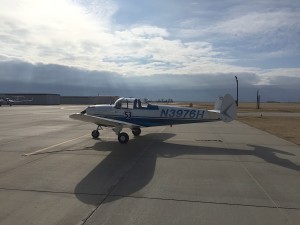
The engine runs off the nose tank, sometimes called the header tank. The gas flows down from the header to the carburetor by gravity. An engine-driven fuel pump pulls gas from the two interconnected wing tanks to fill the header, which overflows back down into the wings. Like a beating heart, the pump keeps the fuel constantly flowing between the tanks. The whole design is a great safety feature: If the heart fails, the engine doesn’t die. In fact, if the pump fails you’d have about an hour’s flying time. There’s a float gauge on the nose that lets you know if the level starts to drop, signaling either empty wings or a dead fuel pump.
While the lineman gassed me up, I admired the other plane on the ramp. Sharing the tarmac with my expensive-to-maintain antique was a brand spanking new expensive-to-buy Diamond Twin with the aeronautical equivalent of the curves of a Playboy centerfold. I gotta say, this is one sexy airplane. But despite being new, the owner was having some mechanical issues dealing with the brakes. I’m embarrassed to admit it, but I found some sort of perverse reassurance in the fact that new planes aren’t immune to expensive maintenance issues. My only defense is that our last annul cost nearly half as much as the plane herself did, and I’m guilty of wondering whether our family’s money might have been better spent on a newer airplane. Apparently not.
At noon as I headed for my ride, I told the twin owner that I hoped the weather gods were feeling kinder than the brake fluid gods (he assured me he thought they would be) and I was off and on my way.
I cruised in sunlight at first and wondered if I should have taken my winter flight jacket off, but soon enough I was under a high blanket of grey again and the temperature in the cockpit dropped. The ceiling seemed to stay put, but the stupid ground got higher and higher with each passing mile. The rules for the kind of airspace I was in state that I’m supposed to stay 500 feet below the clouds. How high off the ground? Actually, there is no set altitude over empty, open prairie. You just have to be high enough to land in an emergency without hurting anyone on the ground.
The horizon grew brighter and brighter as my opening between sky and ground got tighter and tighter. The final edge of the clouds clung to a ridgeline southwest of Meade. I sailed over the flat, open ridge at 200 feet above the ground and then burst into bright, clear sunshine. For a moment all was calm and beautiful.
And then the turbulence hit.
You can almost count on angry air between frontal boundaries, and this region did not disappoint. I had a momentary vision of my being bounced right out of the cockpit, and falling (with 12 bottles of expensive red wine) to the earth below. I tightened my seatbelt and shoulder belt, and then did the same for the case of wine that was riding shotgun with me. I climbed back up to 500 feet, then added another two hundred for good measure, Tessie was like a bucking bronco. I held onto her yoke with my left hand and onto her windshield support with my right. My only mission was to get the wings level when the churning air knocked one wing higher than the other. The up and down lurching I didn’t worry about. One blast of air would send us up a hundred feet, the next would fall on us like a hammer, driving us back down again.
And just when I was far enough out from the frontal boundary to escape the turbulence, I entered a popcorn sky. Well, that’s what I call it. I’m sure that’s not it’s formal name. But a popcorn sky is one populated by a sea of small cumulus clouds, all at the same altitude.
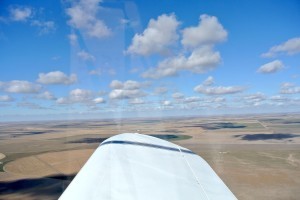
The game is harmless, but tiring. Like taking a roller coaster to work. After about one hour of it, I was sure glad I was transporting wine, not champagne.
And finally, after hours of being jostled and jolted, Runway 26 at my homebase appeared off my nose. I was glad to be home again: I’d had enough flying.
Well, at least for a day or two.
Access William Dubois' story on his Plane Tales blog at http://www.planetales.net/plane-people/shaken-not-stirred







